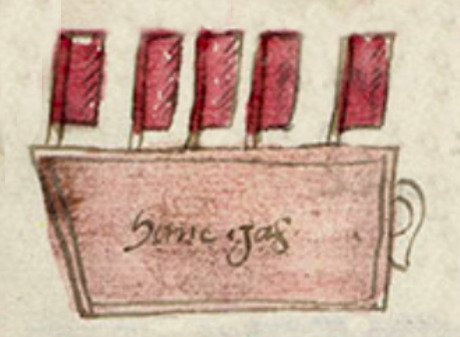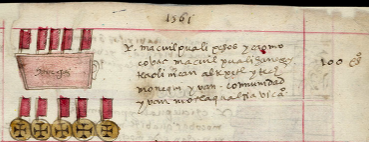macuilpohualli fanegas (CST41)
This is a painting of the simplex glyph plus notations for the expression macuilpohualli fanegas (one hundred fanegas, which is a Spanish measuring implement and a loanword that entered Nahuatl). Five flags, each having the value of twenty (cempohualli), relate that the quantity of grain in this case amounted to 5 x 20 or 100. The flags are on sticks, standing upright, with their red banners flying toward the viewer’s right. Each banner has short lines that give it something of a three-dimensionality. Each fanega was about 1.5 bushels, according to the dictionary. The fanega looks like a pink wooden box with a slight point on the left end and a handle on the right end.
Stephanie Wood
The 100 fanegas had a value in this time and place of 100 pesos, according to the companion text, i.e., one peso per fanega. This food was consumed by the community and some was given to feed the vicar in the local Catholic church. (See Kevin Terraciano, Codex Sierra (2021), pp. 125 and 158 for the Nahuatl transcription and English translation.
Stephanie Wood
1550–1564
Jeff Haskett-Wood
maíz, comida, semillas, fanegas

macuil(li), five, https://nahuatl.wired-humanities.org/content/macuilli
cempohual(li), twenty, https://nahuatl.wired-humanities.org/content/cempohualli
fanega, a measure of grain, about 1.5 bushels, https://nahuatl.wired-humanities.org/content/fanega
cien fanegas
Stephanie Wood
Códice Sierra-Texupan, plate 41, page dated 1561. Origin: Santa Catalina Texupan, Mixteca Alta, State of Oaxaca. Kevin Terraciano has published an outstanding study of this manuscript (Codex Sierra, 2021), and in his book he refers to alphabetic and “pictorial” writing, not hieroglyphic writing. We are still counting some of the imagery from this source as hieroglyphic writing, but we are also including examples of “iconography” where the images verge on European style illustrations or scenes showing activities. We have this iconography category so that such images can be fruitfully compared with hieroglyphs. Hieroglyphic writing was evolving as a result of the influence of European illustrations, and even alphabetic writing impacted it.
https://bidilaf.buap.mx/objeto.xql?id=48281&busqueda=Texupan&action=search
The Biblioteca Digital Lafragua of the Biblioteca Histórica José María Lafragua in Puebla, Mexico, publishes this Códice Sierra-Texupan, 1550–1564 (62pp., 30.7 x 21.8 cm.), referring to it as being in the “Public Domain.” This image is published here under a Creative Commons license, asking that you cite the Biblioteca Digital Lafragua and this Visual Lexicon of Aztec Hieroglyphs.







